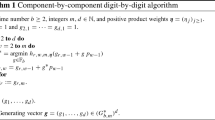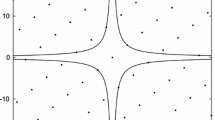Summary.
This paper introduces a new class of equal-weight integration rules on the hypercube. The points are cyclically generated in a different way to the method of good lattice points. The main justification for these integration rules is that they are capable of having high degree under a slight modification to the definition of degree. Some theorems are presented which provide conditions under which congruential integration rules exist for degree up to thirteen. Actual integration rules are provided for up to seven million points and up to five hundred dimensions.
Similar content being viewed by others
References
Bungartz, H.-J.: Dünne Gitter und deren Anwendung bei der adaptiven Lösung der dreidimensionalen Poisson-Gleichung. PhD Thesis, TU München
Butler, N.A.: Optimal and orthogonal Latin hypercube designs for computer experiments. Biometrika 88, 847–857 (2001)
Cools, R.: Constructing cubature formulae: the science behind the art. Vol.6 of Acta Numerica, Cambridge Univ Press, Cambridge 1997, pp. 1–54
Cools, R., Novak, E., Ritter, K.: Smolyak’s construction of cubature formulas of arbitrary trigonometric degree. Computing, 62 147–162 (1999)
Faure, H.: Discrépance de suites associées à un système de numération (en dimension s). Acta Arith. 41, 337–351 (1982)
Hardy, G.H., Wright, E.M.: Introduction to the Theory of Numbers. Clarendon Press, Oxford, 1954
Gerstner, T., Griebel, M.: Numerical integration using sparse grids. Numerical Algorithms, 18, 209–232 (1998)
Godement, R.: Algebra, Hermann, Paris, 1968
Halton, J.H.: On the efficiency of certain quasi-random sequences of points in evaluating multi-dimensional integrals. Numer. Math. 2, (1960) 84–90, Correction Numer. Math. 2, (1960) 196
Hickernell, F.J.: Obtaining O(N-2+ε) convergence for lattice quadrature rules. In: K.T. Fang, F.J. Hickernell, H. Niederreiter (eds.), Monte Carlo methods and quasi-Monte Carlo methods 2000, pp. 274–289, Springer-Verlag, Berlin, 2002
Hlawka, E.: Zur angenäherten Berechnung mehrfacher Integrale. Monatsh. Math., 66, 140–151 (1962)
Korobov, N.M.: The approximate computation of multidimensional integrals. Dokl. Akad. Nauk. SSSR, 124 (1959), pp. 1207–1210. (In Russian)
Lyness, J.N.: Notes on lattice rules. J.Complexity, 19, 321–331 (2003)
Niederreiter, H.: Quasi-Monte Carlo methods and pseudo-random numbers. Bull. Amer. Math. Soc. 84, 957–1041 (1978)
Niederreiter, H.: Low-discrepancy and low-dispersion sequences. J. Number Theory, 30, 51–70 (1988)
Sloan, I.H., Joe, S.: Lattice methods for multiple integration. Clarendon Press, Oxford, 1994
Smolyak, S.A.: Quadrature and interpolation formulas for tensor products of certain classes of functions. Soviet. Math. Dokl. 4, 240–243 (1963)
Sobol’, I.M.: The distribution of points in a cube and the approximate value of integrals. Zh. Vychisl. Mat. i Mat. Fiz. 7, 784–802 (1967)
Stroud, A.H.: Approximate calculation of multiple integrals. Prentice-Hall, Englewood Cliffs, NJ, 1971
Williams, E.J.: Experimental designs balanced for the estimation of residual effects of treatments. Aust. J. Sci. Res., A2, 149–168 (1949)
Author information
Authors and Affiliations
Corresponding author
Additional information
Mathematics Subject Classification (2000): 65D30, 65D32
Acknowledgement I would like to thank the editors and referees for their very many helpful and knowledgeable comments.
Rights and permissions
About this article
Cite this article
Butler, N. A new class of equal-weight integration rules on the hypercube. Numer. Math. 99, 349–363 (2004). https://doi.org/10.1007/s00211-004-0562-5
Received:
Revised:
Published:
Issue Date:
DOI: https://doi.org/10.1007/s00211-004-0562-5




